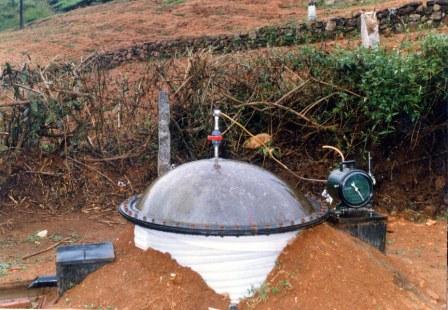|
|
|
|
|
|
|
|
 |
|
|
|
||||
|
|
Biogas Biogas - The Developed Methanogenesis MCRC has been working since 1977 on various biogas systems to produce methane for sustainable fuel supply to rural areas. After 1980s the methanogenesis work took various shapes with applicative models for different areas. For example the small scale anaerobic digestion systems developed for methane production, which work at tropical as well as temperate areas with appropriate techniques. This is a portable model which operates minimum with low quantity of input. Anaerobic fermentation is a biological process which takes place in the absence of air, resulting in production of methane, carbon dioxide and water with cattle dung as substrate. In an effort to improve the design of anaerobic systems, reactors of different scales were fabricated and studied. Small-scale anaerobic digestion systems for rural village farms Three digesters of 50-liter capacity were fabricated with modifications compared to that of conventional digesters. The treatments such as phototropic bacteria, phosphate solubilizers and phosphate solubilizers with rock phosphate were added to the digesters. The design was modified based on the above treatments of which the dome was replaced with PVC sheet for phototropic bacteria addition so as to enable the entry of sunlight for its growth. Digesters of 100-liter capacity were made with several improving design concepts. The treatments given were rock phosphate addition to the cowdung. Biogas from the above digesters was monitored and the digesters were monitored and the digested slurry was added to selected plant of study such as okra and groundnut. Plant parameters as well as soil analysis were carried out. A I cum digester with 1000 liter capacity was designed amalgamating the basic concepts with novel techniques in certain aspects of operations. Studies on H2S inhibition were undertaken with addition of formaldehyde and nickel sulphate. A training programme was organized at MCRC for the villagers from the selected village Vadakkadambadi on “Biogas production and its use” to expose them to biogas technology and biogas system fabrication. Training programme on Biogas at Vadakadambadi Biogas in Hilly Regions Biogas for its energy utilisation becomes mandatory in hilly areas, which are predominant with low temperature and are also isolated from the mainstream power grid networks. Optimization of functional biogas system in hilly areas was investigated through a project sponsored by MNES, New Delhi. This aims to produce or enhance the biogas production with high calorific value by applying the physical, enzymatic and microbial parameters. Biogas reactors of varying capacities (1- 3000 L) were fabricated in the Centre and studied at Valparai and Ootacamund. Apart from using cattle dung as a substrate, bison dung and different plant leaf biomass were also used for biogas generation. Optimization of functional biogas system in hilly areas Developed microbial consortia, which could produce biogas even at low temperature in a sustained manner. Biogas reactors of varying capacity (IL-3000 L) were fabricated to study the biogas production at various climatic conditions. Studies were carried out at Chennai, Valparai and Ootacamund where the ambient temperature is 35, 25 and 15°C respectively. Biogas generation was demonstrated from various substrates viz, Cow dung, bison dung, horse dung and leaf biomass of different plants. Production of methane was found to be maximum with green light. Lantana sp. Biomass and cowdung medium in the ratio of 1:4 produced maximum biogas with high calorific value.
|
|
|
|
